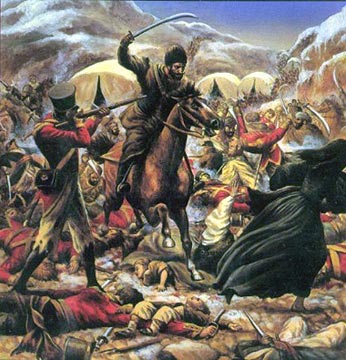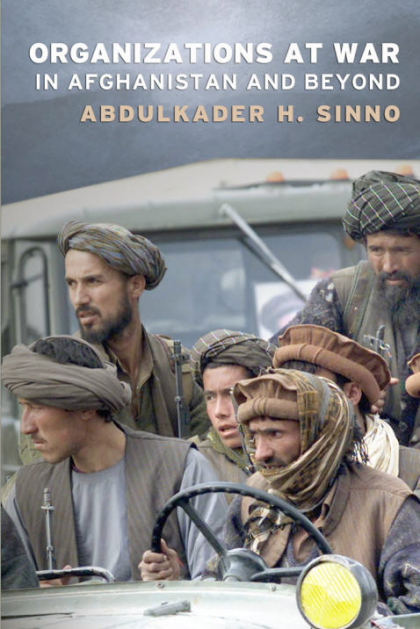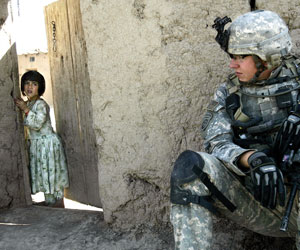Jul.01.2010
5:17 pm
by Ed Beakley
EEI#33 “What Kind of War?” – McChrystal and Rolling Stone: Elements of self-inflicted “system” perturbation
The story of interest over the past days in regard to Rolling Stone’s “The Runaway General – Stanley McChrystal, Obama’s top commander in Afghanistan, has seized control of the war by never taking his eye off the real enemy: The wimps in the White House” does not go down easily, for more than just the obvious reasons. I am reminded of General Rupert Smith’s comment used in the completing post for the core What Kind of War series:
… we are living in a world of confrontations and conflicts rather than one of war and peace; one in which the clear categories of security and defence – the basic purposes for which force is used – have merged… This is no longer industrial war… absolute and clear threats in recognizable groupings, and… stable political contexts for operations… The threats … are of and amongst the people – in the flesh and in the media – and it is there that the fight takes place. (My emphasis added)
Systems disruption occurred or created – how and for what reason or no reason? Now that the crisis has passed – in short McChrystal gone, General Petraeus confirmed – it would seems a good time to consider other aspects in the context of “what kind of war is it” with emphasis that Project White Horse 084640 asks you to look at conflict in this century in conjunction with an overarching framework that also includes the impact of catastrophic disasters, globalization, and information technology. And then asks, first, are we in a century of unconventional crisis, and how do we make decisions in severe crisis? We may never understand why Rolling Stone, nor why a four star general and staff acted as they did, but PWH suggests, the authors below can be read with six threads in mind that will remain both over there and over here:
- War, warfare, violence, and conflict in this century
- How we view, categorize, and respond to crisis
- Control and impact of the narrative
- Impact of the information sphere on organizational response, the media, rumor, how we think, how we decide
- System perturbation, purposeful or unintended, in a system-of-system world existing in a state of unstable equilibrium
- Leadership in complex environments
Over the jump, 10 articles from CNN, Foreign Policy, World Politics Review, The New York Times, Los Angeles Times, World Policy Institute, and Military.Com
1) Islamist websites: McChrystal fired because war is lost (CNN)
The recent change in commanders in Afghanistan is proof the U.S and its allies have lost the war, statements posted on two Islamist websites said Thursday… The Taliban spokesman said the change in command is useless because Petraeus, the new Afghan commander, is weak. “Indeed, he has got no (more) special qualities than General McChrystal had,” Ahmadi said in his statement…. In another statement, a group calling itself the Islamic Emirate of Afghanistan said Petraeus is mentally worn out because of the lengthy war, which began in October 2001. …”Nine years of military actions, different strategies and back-breaking monetary and life damages at the hands of mujahideen have left the crusaders totally in distress,” the statement said.
2) ‘Runaway general’ or runaway reporter? by Michael Innes (CNN)
Hastings clearly demonstrates a keen eye for off-color detail, but fails to weave the threads into something more coherent or meaningful. Getting the facts straight and reporting them is one thing; knowing your subject and making sense of it is quite another.
3) The politics of being a top general, by Lt. Gen. Russ Honore (USA-Ret) (CNN)
When you form a team, why do you try to form a team? Because teamwork builds trust and trust builds speed. There’s always the undercurrent of a little friction in that team, but if that’s made public, then it can deteriorate the public trust between people. Whoever hasn’t violated that trust should cast the first stone.”
4) What happened in Paris…, by Peter Feaver (Foreign Policy)
If you read the Rolling Stone article carefully, you can see that the reporter, Michael Hastings, has woven three stories together. One story is the story of General McChrystal trying to keep up morale in a tough war with his troops thinking he is too worried about civilian casualties …I bet this is the story Hastings pitched to McChrystal’s staff and the story McChrystal thought was being reported. … The second story is Hastings’s rather tendentious reporting on what McChrystal’s enemies and critics say against him — their complaints, and their doubts about the war. … I suspect that this is the story Hastings pitched to his editor. The whole thing has the feel of a hungry guy hoping to hunt a big trophy kill: taking down a four-star hero and showing that his war plan … is fatally flawed and doomed to failure ….The problem for McChrystal is that there is a third story woven through the article. This is the story of McChrystal and his staff on an unexpected layover in Paris when a plane is grounded because of the volcano. This part of the story has a “weekend in Vegas” feel to it. …This third story was an accident – serendipity for the reporter and a train-wreck for McChrystal. The underlying facts are not surprising or accidental at all.
5) The Culture of Exposure, by David Brooks (The New York Times)
…after Vietnam, an ethos of exposure swept the culture. The assumption among many journalists was that the establishment may seem upstanding, but there is a secret corruption deep down. It became the task of journalism to expose the underbelly of public life, to hunt for impurity, assuming that the dark hidden lives of public officials were more important than the official performances. Then came cable, the Internet, and the profusion of media sources. Now you have outlets, shows and Web sites whose only real interest is the kvetching and inside baseball. In other words, over the course of 50 years, what had once been considered the least important part of government became the most important. These days, the inner soap opera is the most discussed and the most fraught arena of political life.
And into this world walks Gen. Stanley McChrystal.
6) Obama and McChrystal; the Generals need a Lincoln, by Eric Sterner (World PoliticsReview)
… those who focus on McChrystal’s impolitic commentsas justification for his departure risk missing the larger point — namely, the contradictions and fecklessness of a policy that created the frustration on the ground to begin with, and which led some members of McChrystal’s staff to vent their feelings to a Rolling Stone reporter.
… the comments seem to reflect frustration with the administration’s tolerance of political maneuvering, both in Washington and Kabul, that runs counter to that strategy’s effective implementation.First, the president himself announced plans to begin withdrawing forces from Afghanistan in July 2011, sending the signal to a range of factions in Afghanistan and Pakistan that they should begin maneuvering for position after the U.S. withdrawal. …
Second, the U.S. civil-military team in Afghanistan is clearly dysfunctional. Ambassador Karl Eikenberry, an accomplished former general who commanded in Afghanistan, notoriously sent two cables to Washington second-guessing McChrystal’s operational plans and trashing Afghan President Hamid Karzai as an unreliable partner. …
Third, the Rolling Stone article raises the question of the role played by Richard Holbrooke, an accomplished and distinguished, if somewhat temperamental, diplomat and the president’s special representative to Afghanistan and Pakistan. Is such a role even necessary? The president already has a secretary of state, a secretary of defense, an ambassador (normally the president’s representative in the country to which he or she is posted), a national security adviser, a regional combatant commander (at CENTCOM), and a commanding general in the field. With that many cooks in the kitchen, no wonder they cannot all get along
7) Weak Civilians and a Fired General, by Maj. Gen. Patrick Brady (USA-Ret.) (Miliary.com)
Civilian control of the military is as essential to our Republic as is a free press. But does anyone believe that the dynamic between office dwellers from Foggy Bottom and academia and political cronies with authority over snake eaters, captured through the prism of the media (more office dwellers), will result in something productive?
8) On the media: What McChrystal failed to understand, by James Rainey (Los Angles Times)
The general and his aides had faced down terrorists and the enemies of America. They had welcomed into their midst journalists from top news outlets. The result had been stories that mostly made the men running the war in Afghanistan look like a bunch of can-do warriors…. But Team McChrystal and its leader met their downfall this week because they failed to recognize, as soldiers like to say, that the opponent, and the situation on the ground, had changed. … It appears now that the hardheaded, make-my-own-rules military man didn’t recognize that the latest in a series of interlocutors was not like the others. Michael Hastings was the most dangerous kind of adversary — a kindred spirit.
9) At War: Embedistan, by Stephen Farrel (New York Times)
It was not in fact a term born in Iraq — the practice of chroniclers traveling with soldiers is as old as war, and even the word “embedding” itself was in use in the 1990s. But Iraq was certainly where it crossed over into the wider lexicon. Within the military there may now be some debate about whether embedding survives in its current form, after a journalist granted close access helped bring about the downfall of a four-star general within the very military system which spawned it.
10) The Myth of a Kinder, Gentler War, by Michael A. Cohen (World Policy Institute)
According to McChrystal, the “Afghan people are at the center of our mission…in reality they are the mission.” These sentiments are reflective of what has become the new way of American war—population centric counter-insurgency (COIN). The focus on COIN doctrine was enshrined by Gen. David Petraeus and the 2006 publication of the Army and Marine counter-insurgency manual, FM 3-24, which calls for a military approach that seeks to convince the population that counter-insurgents, acting on behalf of a sovereign government, can be trusted and are worthy of popular support.
With its seemingly progressive and humanistic approach, FM 3-24, and counterinsurgency in general, offer a seductive ideal for the future of American war-fighting. But the veneration of COIN conceals a brutal reality. The history of counter-insurgency in the twentieth century is not a story of warm and fuzzy war, of benevolent soldiers providing essential government services to grateful natives, of armed social work, or of the gentleman soldier’s antidote to the Shermanesque notion of Total War. Instead, counter-insurgency is a repeated tale of coercion and violence directed largely against unarmed civilians. And this defines both those COIN efforts that have been successful—and those that have failed.
Closing note: The original articles in the “What Kind of War?” series offered multiple writers and view points on what was originally labeled the Global War on Terrorism (GWOT) and included the thought that the style of war and the lessons learned by our adversaries was far more pervasive and world wide than just the Middle East – in particular the warfare on our Mexican border. An earlier edition of Project White Horse 084640 offered the concept of Fourth Generation Warfare (4GW) for consideration as an appropriate model. In closing the core of the series, I suggested General Rupert Smith’s “war amongst the people” as a final thought related to essential elements of information for a culture of preparedness.
A general is gone, another arrives, 70 plus days into Deepwater Horizon – What do we learn?
Filed in 4GW,Elements of Essential Information,What Kind of War | Comments Off



